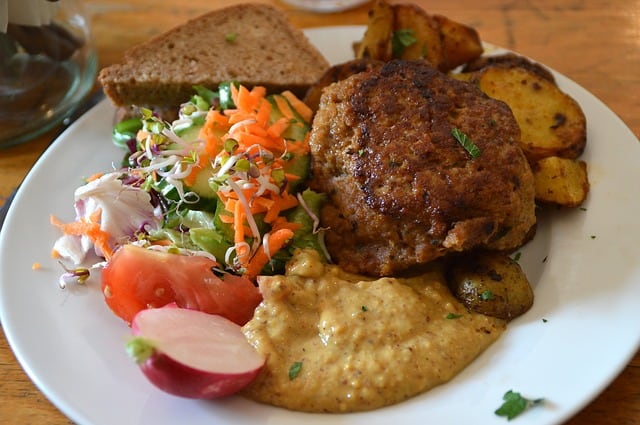
Glycemic Index (GI) and Glycemic Load (GL) help us understand how specific foods we eat impact our blood sugar (or glucose) levels. This in turn has a direct impact on the energy levels you have (or lack), and how quickly excess energy is stored as body fat.
Of the three macronutrient types (protein, fat, and carbohydrates), carbs are the primary energy source the body prefers.
When you consume foods containing carbs (sugars and starches) these are broken down into glucose by your digestive system. The glucose then enters your bloodstream, and is transported elsewhere in your body to be used for energy, or to be stored for later use in the liver and skeletal muscle as glycogen.
What is the Glycemic Index (GI)?
The Glycemic Index (GI) is a relative ranking of the carbohydrate in food items according to how they affect blood glucose levels.
Foods with carbs that break down quickly during digestion and release glucose rapidly into the bloodstream tend to have a high GI index; foods with carbohydrates that break down more slowly, releasing glucose more gradually into the bloodstream, tend to have a low GI index.
Insulin plays an important role in controlling blood sugar levels. Insulin, a signaling hormone created in the pancreas, tells the body’s systems to store the excess glucose in the blood stream, therefore lowering blood sugar levels. Insulin is released in relation to how much carbohydrate is eaten (and how quickly it is absorbed).
When people become insulin resistant (such as with Type 2 Diabetes) the body’s systems do not respond adequately to this signal (or they simply cannot produce enough insulin quickly enough), and blood sugar levels remain chronically high – which has adverse impacts on health. Blood glucose levels above normal are toxic and can cause blindness, kidney failure, or increase cardiovascular risk.
The GI Index is an arbitrary scale, but you can use it to compare foods relative to one another.
A low-GI food will therefore release glucose more slowly and steadily, which leads to normal blood glucose readings. A high-GI food causes a more rapid rise in blood glucose level and is suitable for energy recovery after exercise or for a person experiencing hypoglycemia. Hypoglycemia, also known as low blood sugar, is when blood sugar decreases to below normal levels. It can be a dangerous condition. Symptoms typically come on quickly and can include: clumsiness, trouble talking, confusion, loss of consciousness, seizures, or even death.
Some examples of the GI classification of common foods:
| Classification | Glycemix Index (GI) Range | Examples |
|---|---|---|
| Low GI | 55 or less | beans (black, pinto, kidney, lentil, peanut, chickpea); small seeds (sunflower, flax, pumpkin, poppy, sesame, hemp); walnuts, cashews, most intact whole grains (durum/spelt/kamut wheat, millet, oat, rye, rice, barley); most vegetables, most sweet fruits (peaches, strawberries, mangos); mushrooms, milk, pasta |
| Medium GI | 56–69 | orange juice, honey, basmati rice, and whole grain bread, white sugar, raisins, prunes, pumpernickel bread, cranberry juice, regular ice cream, bananas, sweet potatos |
| High GI | 70 and above | Potatoes, white bread, most white rice, corn flakes, white potato |
Foods with a low GI index tend to help you feel fuller (satiety) and typically provide more stable energy levels.
But there’s more to the picture than just the GI index. It’s equally as important to consider how much carbohydrate you are eating, as well as what else you are eating at the same time.

What is the Glycemic Load (GL)?
Glycemic Load (GL) also takes into account serving size, and the amount of carbohydrate in that serving. So it’s a fundamentally more useful metric. The glycemic load (GL) rates carbohydrates according to the glycemic index and the amount of carbohydrate in the food. It’s calculated as the GI number multiplied by the amount of carbohydrates per serving, divided by one hundred.
As an example, watermelon is a high-GI food rated at a 72. But it’s only 5% carbohydrate per serving – so it’s got a GL of 4. Compare that with white rice, which is also a 72 GI rating – but is a GL of 29.
| FOOD | Glycemic index (glucose = 100) | Serving size (grams) | Glycemic load per serving |
|---|---|---|---|
| Bagel, White, Frozen | 72 | 70 | 25 |
| Hamburger bun | 61 | 30 | 9 |
| White bread | 75 | 30 | 11 |
| Oatmeal | 55 | 250 | 13 |
| White rice | 72 | 50 | 29 |
| Brown rice, steamed | 50 | 150 | 16 |
| Banana, raw, average | 48 | 120 | 11 |
| Watermelon | 72 | 120 | 4 |
Food in Combinations
And last, but not least, a meal is going to have an average Glycemic Load based on everything you are eating. What’s more, fat and protein will tend to delay the uptake of carbohydrates as well. Do you need to compute the GL of your meal? No. Use it as a guideline to make better food choices.
In Summary
In summary, we recommend you use your knowledge of GI and GL to make better food choices. But remember that a low GI rating of a food does not mean you should eat a larger serving of that food – the total amount of carbohydrate and calories consumed is still important. Similarly, high GI foods (such as watermelon and grapes) may actually have smaller amount of total carbohydrates – along with other benefits like fiber, vitamins, and minerals – so they are still a nutritious food.
Get in tune with how your body handles different foods, and make the right choices for you.
References
- Glycemic index for 60+ foods
- “International tables of glycemic index and glycemic load values: 2008” by Fiona S. Atkinson, Kaye Foster-Powell, and Jennie C. Brand-Miller in the December 2008 issue of Diabetes Care, Vol. 31, number 12, pages 2281-2283.


Tim is the founder of FitAtMidlife.com – an avid gym rat for 30+ years, he’s a reviewer of many, many shoes – and founder of the Speed Bag Gathering – the world’s only gathering of speed bag punching enthusiasts. See more gym reviews at Tim’s YouTube channel.

Thank you for bringing this to my attention. I have updated the link, it seems the article has changed since I originally referenced it. The 2nd link does contain a lot of information including both GI and GL values. For convenience, here’s the direct link to the supplemental data for that article: http://care.diabetesjournals.org/content/diacare/suppl/2008/09/18/dc08-1239.DC1/TableA1_1.pdf and http://care.diabetesjournals.org/content/diacare/suppl/2008/09/18/dc08-1239.DC1/TableA2_1.pdf
You need to update your link above. The page reached by clicking on “Glycemic index and glycemic load for 100+ foods” above goes to a page titled “Glycemic index for 60+ foods” and has no glycemic load data on it.